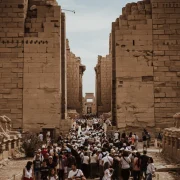
East Bank Luxor Tour: 5 Unmissable Highlights to Explore
The East Bank Luxor Tour is one of the most amazing experiences you can have when visiting Egypt, combining the grandeur of history with the splendor of the Pharaonic civilization that has withstood the test of time for thousands of years. On the east bank of the Nile, the complex of temples and monuments stands as a living testament to the greatness of the pharaohs and their architectural and artistic creativity.
Table of Contents
ToggleEast Bank Luxor Tour: A Journey to the Heart of Ancient Egyptian Civilization:
East Bank Luxor Tour takes you on a journey through time, starting from the Karnak Temple with its massive columns and inscriptions that tell the legends of gods and kings, passing by the Luxor Temple, which tells the stories of ancient religious celebrations and embodies the spirit of Thebes, the capital of ancient Egypt. Every stone in these temples speaks the language of a civilization that laid the foundations of science, astronomy, and engineering.
East Bank Luxor Tour includes visits to distinguished museums such as the Luxor Museum and the Mummification Museum, where visitors discover amazing secrets about the lives of ancient Egyptians, their religious rituals, and the mummification methods that have baffled the world. The East Bank Luxor Tour is not just a tourist visit; it’s an inspiring journey that reveals how ancient Egypt possessed the secret of immortality, offering you an exceptional and unforgettable experience.
Karnak Temple: The Largest Religious Complex in the Ancient World
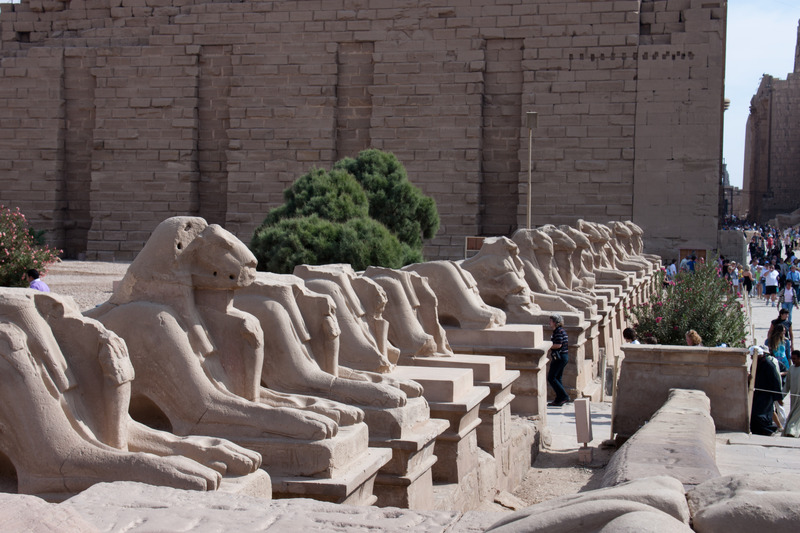
The first stop on the East Bank Luxor Tour is at one of the greatest temples constructed in ancient Egypt, the Karnak Temple. It was built over a period of more than 2,000 years, from the Middle Kingdom to the Ptolemaic period, with the participation of several kings, most notably Thutmose III and Ramesses II.
The Karnak Temple is a massive complex that includes temples, chapels, sanctuaries, and massive obelisks, all dedicated to the god Amun-Ra, his wife Mut, and their son Khonsu. The temple spans an enormous area of nearly 200 acres, making it the largest religious complex in the ancient world.
The East Bank Luxor Tour takes you to a massive gateway known as the “Surū” (pylons), a majestic entrance decorated with inscriptions recording the victories of the pharaohs. These massive pylons were used to demonstrate the power and status of kings before the people and the gods. The temple also contains several magnificent obelisks, such as the famous Obelisk of Hatshepsut, which still stands tall after thousands of years.
The East Bank Luxor Tour takes you to the Great Hypostyle Hall of Karnak Temple, a unique architectural masterpiece comprising 134 massive columns reaching a height of 21 meters. These columns are decorated with inscriptions and motifs depicting religious scenes and royal celebrations. The hall resembled a forest of columns and hosted the most important religious rituals, making it the spiritual heart of the temple.
Karnak Temple Processional Hall:
Explore the intricate details of Karnak Temple during your East Bank Luxor Tour. It includes the ceremonial hall used by the pharaohs for major festivals, most notably the Opet Festival, during which the procession of the god Amun moved from Karnak to Luxor Temple via the Avenue of Sphinxes. These celebrations embodied the sacred relationship between the king and the gods and affirmed the legitimacy of the pharaoh’s rule as the son of God on earth.
The inscriptions on the walls of Karnak Temple during your East Bank Luxor Tour will tell you that the temple served as the main center for the worship of the god Amun-Ra, who was associated with power, strength, and victory. Therefore, Karnak Temple was a symbol of the religious and political unity of ancient Egypt. Kings competed to add new parts to the temple to immortalize their names and increase their spiritual and political influence. Even today, Karnak remains a testament to the greatness of the pharaohs and their advancement in architecture and religious thought.
Luxor Temple: The Magic of Religious and Royal Celebrations
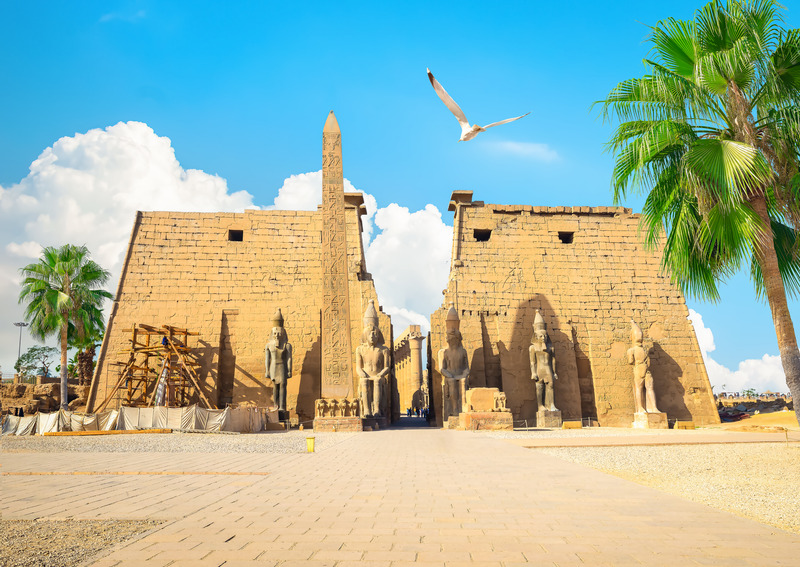
Egypt Travel will accompany you to Luxor Temple, the second most important stop on the East Bank Luxor Tour. It is one of the most magnificent temples in ancient Egypt and the most closely linked to religious and royal life during the Pharaonic era. It was built by King Amenhotep III and completed by Ramesses II, serving as the center of major celebrations, particularly the Opet Festival, which brought together the temples of Karnak and Luxor in a majestic procession symbolizing the renewal of royal life and authority.
You will explore the splendor of its design, reflecting the temple’s spiritual and political role as a symbol of unity between the king and the gods. The most prominent feature of Luxor Temple is its massive gateway adorned with statues of Ramesses II, the famous obelisk that stands tall in front of its entrance, and its massive edifice leading to a spacious courtyard that served as a theater for religious rituals.
The Great Hypostyle Hall showcases the grandeur of ancient Egyptian architecture with its splendor and decorations that immortalize scenes of victory and worship, providing visitors with a unique experience combining history and faith. During the East Bank Luxor Tour, you will witness the solidity of the temple, which has endured through generations and civilizations.
You will witness the succession of civilizations over the centuries, from the Greeks and Romans to the Christians, who converted parts of it into churches, and the Muslims, who built the Abu al-Hajjaj al-Aqsar Mosque within it. This cultural and religious intermingling adds a new dimension to the charm of the temple, making it a living canvas that embodies the eternal spirit of Egypt, combining the fragrance of the past with the diversity of the present.
The Avenue of Sphinxes: The Legendary Link Between Karnak and Luxor
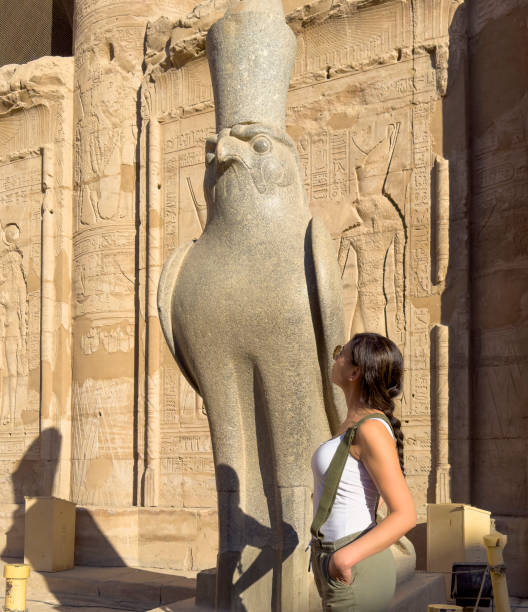
The East Bank Luxor Tour is full of important and inspiring stops, most notably exploring the Avenue of Sphinxes, one of the greatest architectural achievements of ancient Egypt. Built as a sacred passageway linking the Karnak and Luxor temples, it stretches approximately 2.7 kilometers.
The road was lined with rows of colossal ram statues, representing the god Amun-Ra, signifying divine protection and the sanctity of the procession that passed through it. This road was not just a stone walkway; it was a symbol of the spiritual and political power that united religion and royalty.
Within the East Bank of Luxor Tour, you will stand on the main stage of the Opet Festival celebrations, where the royal and religious procession set out from Karnak Temple to Luxor Temple in a grand festive atmosphere. The statues lined both sides like eternal guardians accompanying the procession, while the sounds of the hymns echoed.
Hymns and hymns, making the road a legendary bridge between humans and gods, between earthly life and divine holiness.
Luxor Museum: A Window into the Secrets of the Pharaohs
The East Bank Luxor Tour takes you to a very important stop, stopping to visit the Luxor Museum. Within its halls, you will enjoy a unique experience learning about the secrets of the Pharaonic civilization through a carefully selected collection of archaeological treasures. Opened in 1975, it serves as a living window into the history of ancient Thebes, the capital of the Pharaohs. It features modern exhibition halls that combine artistic creativity with historical accuracy.
On the East Bank Luxor Tour, see up close statues of great kings such as Amenhotep III and Ramses II, as well as statues of priests and gods found in the “Great Discovery” at Karnak Temple. You’ll also find rare artifacts from the tomb of Tutankhamun, a magnificent collection of chariots, and inscriptions that tell the details of religious and political life in ancient Egypt.
The Luxor Museum is a center for education and heritage preservation, offering visitors a deeper understanding of the greatness of the pharaohs, their arts, and their beliefs. A visit to the Luxor Museum on the East Bank Luxor Tour is like a journey through time, immersing visitors within walls that tell the stories of kings, priests, and soldiers, leaving with a lasting impression of the genius of the ancient Egyptians.
Mummification Museum: Discovering the Secrets of Immortality
Egypt Tours, as part of its East Bank Luxor Tour program, includes a visit to the Mummification Museum, which reveals the secrets of one of the greatest techniques of the pharaohs: the art of mummification. As you wander through the museum’s halls, you will discover how the mummy was prepared and the body preserved after death, a process linked to the ancient Egyptians’ beliefs about resurrection and immortality in the afterlife.
On the East Bank Luxor Tour, you will gain a close look at the collection of tools and materials used by the priests in the mummification process, along with models of human and animal mummies such as crocodiles, birds, and cats, illustrating the religious and scientific dimensions of this practice. You can also see canopic jars used to preserve organs, as well as paintings and drawings explaining the intricate stages of the process.
Best Time to Visit the East Bank of Luxor
Egypt Travel advises its existing and new clients that the best time to take the East Bank Luxor Tour is during the winter, from November to March. The weather is mild and pleasant, away from the intense summer heat, allowing visitors to enjoy a relaxing tour of the Karnak and Luxor Temples and the nearby museums. Daytime temperatures during this period often range between 20 and 25 degrees Celsius, making walking and touring the archaeological sites a pleasant experience.
If you want to fully enjoy the East Bank Luxor Tour, set off early in the morning. This is the best time to do so, as the weather is cooler and there are fewer crowds, allowing for a quieter photo opportunity and contemplating the architectural details and inscriptions. An evening visit to Luxor Temple is also very special, as the temple is illuminated with lights, creating a magical atmosphere that blends history and spirituality.
Important Tips for Enjoying the East Bank Luxor Tour
Egypt Travel advises its existing and new clients to start the East Bank Luxor Tour early in the morning to avoid the heat and enjoy the tranquility away from the crowds. Bring a hat, sunglasses, sunscreen, and a bottle of cold water to keep you active while touring open temples like Karnak and Luxor. Comfortable shoes are essential due to the long distances and the extensive walking between the temple corridors and halls.
Second, make your visit even more enriching by hiring a local tour guide with Egypt Travel’s expertise in Egyptology who will explain the details of the inscriptions and architecture. Every inscription and symbol has a profound religious or political meaning. Don’t miss visiting lesser-known landmarks like the Luxor Museum and the Mummification Museum, which offer a clearer insight into the lives and beliefs of ancient Egyptians.
The East Bank Tour: An Invitation to Touch the Spirit of History
The East Bank Luxor Tour is an open invitation to touch the spirit of history and experience the heart of the Pharaonic civilization. Here, the visitor stands before the temples of Karnak and Luxor, where the architectural grandeur and spirituality of the rituals that connected kings and gods are evident. Walking among the massive columns and intricately carved reliefs awakens an inner sense that you are part of a living scene thousands of years old.
The East Bank Luxor Tour is a journey through time that reflects the ancient Egyptians’ vision of life and immortality. At Karnak Temple, a history of religious rituals and grand celebrations unfolds before you, while at Luxor Temple, you are transported into a magical festive atmosphere that represented the heart of the royal Opet festival. Every corner and every statue tells a story of the pharaohs’ faith and the power of their kingship.
Recent Posts
East Bank Luxor Tour: 5 Unmissable Highlights to Explore
Tour luxor abu simbel : 7 Reasons This Journey Will Amaze You
Luxor Aswan Tour: Top 10 Temples and Tombs to Explore
All Categories
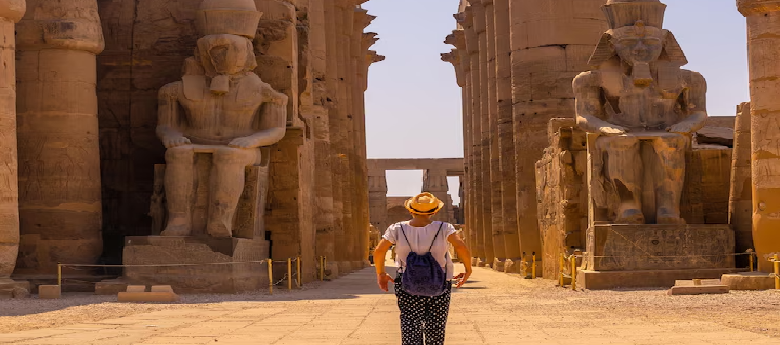
Luxor


